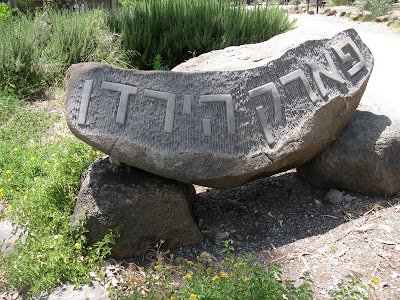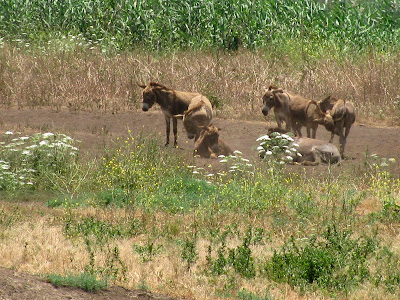We decided to follow the Aqueduct Route - a walk along the Jordan River among the remains of ancient watermills. Though the leaflet that we picked up at the entrance of the park warned us that this route is not suitable for midday walks in the summer, we decided to take a chance and try it anyway. The hike was easy enough and the views lovely, though the paths clearly hadn't been cleared yet after the winter rains and it was sometimes hard to get through.
The route was a circular one, beginning and ending at the site of a watermill. In the past, at least a dozen flour mills were in operation in the area that is now the park, driven by the abundant waters of the Jordan River that flowed to the mills along four plastered channels. One of these channels has been restored, and it carries water for a distance of 600 metres to two reconstructed flour mills near the main parking area. Both are chute mills, in which the water flows down a diagonal chute to the lower floor of the structure, where it turns a large paddled waterwheel attached to an axis that rotates the upper millstone on the floor above, grinding the wheat grains into flour.
Down by the river we gave up following the blue Aqueduct Route and switched over to the yellow Eden Route which was clearer. Here, rather than climbing, we enjoyed a pleasant stroll along the banks of the Jordan River in the shade of willow trees and through natural tunnels created by the tall reeds.
Our next stop was at Tell Bethsaida (et-Tel), in the southeastern section of the park. Bethsaida ("house of the hunt" in Hebrew) was a small fishing village that sat on a hillside on the northeastern end of the Sea of Galilee. In the First Temple period Bethsaida was a fortified city know as Tzar, capital of the Kingdom of Geshur. Geshur maintained close relations with King David, who married Maachah, daughter of Talmai, King of Geshur, who gave birth to King David’s son Absalom.
In the New Testament Bethsaida was a place of miracles. Jesus cured a blind man there, turned a few loaves and fishes into food for 5,000, and walked on water. It was also the birthplace of three of Jesus's apostles - Peter, Andrew and Philip.
In the early stages of the Great Revolt of the Jews against the Romans the town was destroyed in a local battle in which the Jewish troops were led by the historian Josephus Flavius (born Yosef Ben Matityahu). Its ruins were uncovered by the American Biblical scholar Edward Robinson in the mid-19th century.
Today the ruins at Bethsaida include a palace, a massive gate to protect a fortified city, and paved roadways and homes. Recent excavations revealed two large Hellenistic-Roman houses that had fishing paraphernalia and several Roman silver and gold coins inside. The other house had its own surprise, with a wine cellar and four intact Hellenistic jars, a gold earring, vineyard pruning tools, and more fishing items.
My friend's cousin, with whom we were staying, was keen to show us Magdala, an ancient city on the shore of the Sea of Galilee, where he had been involved in excavations. The excavations conducted in 2006 found that the settlement began during the Hellenistic period (between the 2nd and 1st centuries BCE) and ended during the late Roman period (3rd century CE). Later excavations in 2009-2013 brought perhaps the most important discovery at the site: an ancient synagogue, called the "Migdal Synagogue", dating from the Second Temple period (50 BCE-100 CE). It is the oldest synagogue found in the Galilee, and one of the only synagogues from that period found in the entire country. The walls of the 120-square-metre synagogue hall were decorated with brightly coloured frescoes and the floors mosaic. Archaeologists also found the Magdala stone, believed to be the centrepiece of a low bimah (where the reader would have knelt to read from the Torah scroll) which has a seven branched menorah carved on it. It is the earliest menorah of that period to be discovered outside of Jerusalem.
Excavations have continued apace, uncovering residential areas, a marketplace and mikvaot. Though the site is managed by the Catholic Church, visitors are able to explore what a Jewish village in Israel would have looked like 2,000 years ago. Rather disconcertingly, a complex of six chapels has been built on the recently excavated flagstone floor of the first-century marketplace, and the ruins of ancient Jewish Migdal have been marked with religious signs informing the visitor of the significance of Jesus, Mary Magdalene and the Church. On the other hand, Magdala is believed to be the birthplace of Mary Magdalene, or "Mary from Magdala".
Until the 1948 Arab–Israeli War, a small Arab village, al-Majdal, stood at the site of ancient Magdala, while nowadays the modern Israeli municipality of Migdal extends to the area.
At this point my friend and I were exhausted! We drove into Tiberias for a quick falafel and walk along the waterfront. Tiberias is a city on the western shore of the Sea of Galilee, named in honour of the second emperor of the Roman Empire, Tiberius. Its Old City holds important Jewish and Christian pilgrimage sites including the Tomb of Maimonides and Abulafia (Etz Chaim) Synagogue. The restaurant-lined waterfront was a pleasant place to walk after a busy day.
The next day it was time to head for home, though there was time for just one more stop. The small, tranquil town of Zichron Ya'akov, located on Mount Carmel, was founded in 1882 by 100 Jewish pioneers from Romania. They named it Tzammarin. The rocky soil of Mount Carmel proved very difficult to farm, and combined with an outbreak of malaria, many of the original pioneers left within a year. However, the following year, the French Jewish philanthropist and winemaker Baron Edmond James de Rothschild visited Zichron Ya'akov and he discovered that the slopes of the Carmel offered superb wine-growing properties. He set about establishing the town as a winemaking town and named it in memory of his father Jacob (Ya’akov in Hebrew; Zichron means Memorial).
Today, the town's main shopping street is lined with cafes and galleries, sitting alongside historic buildings. It is also famous for the Carmel Winery, one of Israel's top vineyards, which I visited back in 2010.
Zichron Ya'akov was also home to the NILI espionage group that supplied intelligence to British military leaders hoping to overtake Palestine from the Ottoman Turks. The Aaronson House, the former private home of the Aaronson family whose family members were involved in the group, is now a museum about the NILI spy ring. I plan to go back there for a visit one day.
Zichron Ya'akov was also home to the NILI espionage group that supplied intelligence to British military leaders hoping to overtake Palestine from the Ottoman Turks. The Aaronson House, the former private home of the Aaronson family whose family members were involved in the group, is now a museum about the NILI spy ring. I plan to go back there for a visit one day.
* This post has been shared on My Corner of the World, Little Things Thursday, Friday Bliss, Floral Friday Fotos, Pink Saturday and All Seasons.













































































